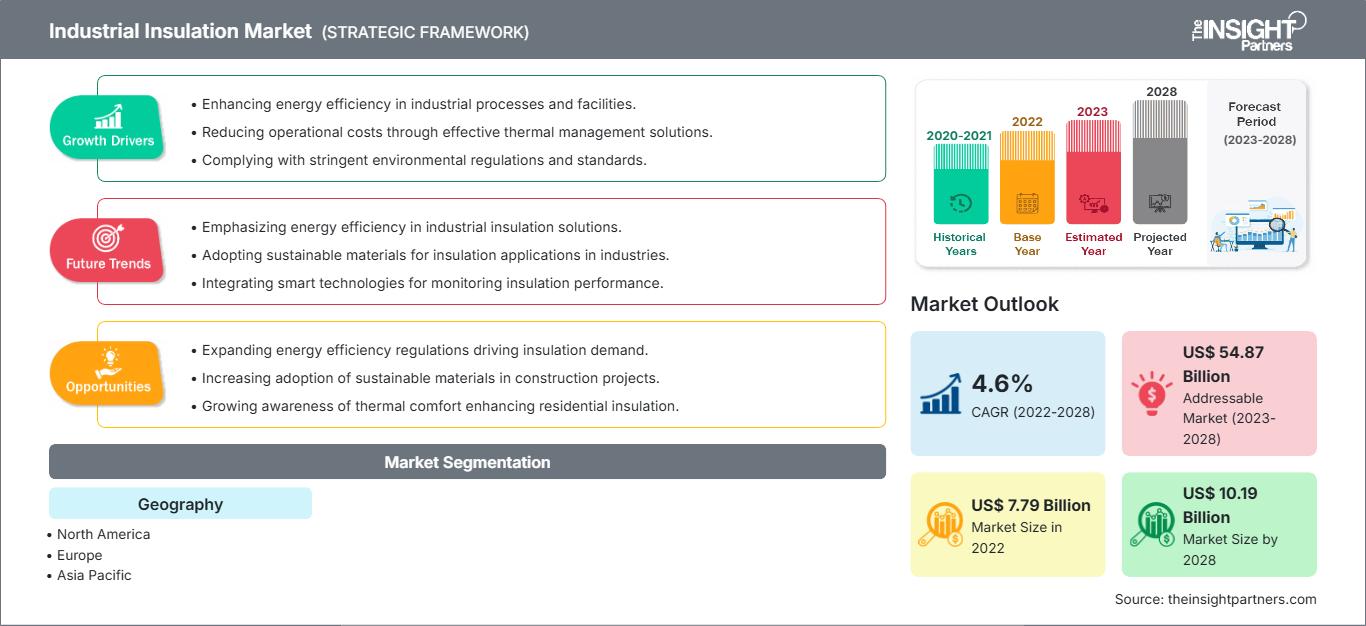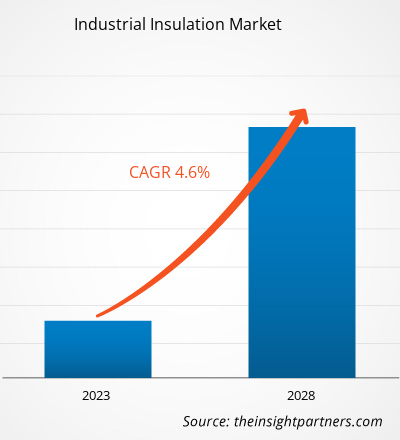[研究报告] 工业隔热材料市场预计将从 2022 年的 77.9391 亿美元增长到 2028 年的 101.8911 亿美元;预计 2022 年至 2028 年的复合年增长率为 4.6%。
市场分析
工业隔热材料在发电、化工和石化、水泥以及食品和饮料等各个行业中发挥着重要作用。工业隔热材料在各种水力发电厂中至关重要,因为它有助于蒸汽锅炉保持温度水平。此外,预计新兴经济体基础设施支出的增加将为预测期内的市场增长提供丰厚的机会。随着全球各国建筑活动的增加,对工业隔热材料的需求也在不断增长。在基础设施中使用工业隔热材料有助于防热、防火和防腐蚀。
增长动力与挑战
全球范围内强制使用隔热材料进行节能的严格法规促进了工业隔热市场的增长。隔热材料可以抵抗热流,也有助于降低加热和冷却成本。强制使用隔热材料进行节能的严格法规是推动工业隔热市场增长的主要因素。节能法规以及石油和天然气、化工和石化、食品和饮料等终端行业对隔热材料的需求正在推动市场的增长。美国机械工程师协会 (ASME)、美国锅炉制造商协会 (ABMA) 和美国材料与试验协会 (ASTM) 等多个协会制定的标准适用于工业设备的设计,以实施安全协议,从而促进了工业隔热市场的增长。工业隔热材料的高安装成本对工业隔热市场构成了挑战。工业隔热材料的安装成本会因类型、设计、规模和复杂程度而异。工业隔热材料的安装是一个复杂的过程,需要先进的工具和操作。此外,还需要一名经过专业培训的人员来评估设施的规模、隔热面积和隔热材料。此外,安装矿棉、泡沫板和玻璃纤维等重型隔热材料需要合格的专业人员,这会增加工业安装成本。
自定义此报告以满足您的要求
您将免费获得任何报告的定制,包括本报告的部分内容,或国家级分析、Excel 数据包,以及为初创企业和大学提供超值优惠和折扣
工业绝缘市场: 战略洞察

- 获取本报告的主要市场趋势。这个免费样本将包括数据分析,从市场趋势到估计和预测。
您将免费获得任何报告的定制,包括本报告的部分内容,或国家级分析、Excel 数据包,以及为初创企业和大学提供超值优惠和折扣
工业绝缘市场: 战略洞察

- 获取本报告的主要市场趋势。这个免费样本将包括数据分析,从市场趋势到估计和预测。
报告细分与范围
《2030年全球工业绝缘材料市场分析》是一项专业且深入的研究,主要关注全球市场趋势和增长机遇。本报告旨在概述全球市场,并按原材料、产品、最终用户和地域对市场进行详细细分。全球工业绝缘材料市场近年来一直保持高速增长,预计在预测期内将继续保持这一趋势。本报告提供了全球工业绝缘材料消费量的关键统计数据,以及主要地区和国家的需求。此外,本报告还对影响主要地区和国家工业绝缘材料市场表现的各种因素进行了定性评估。报告还对工业绝缘材料市场的主要参与者及其关键战略发展进行了全面分析。本文还包括几项市场动态分析,以帮助识别关键驱动因素、市场趋势和有利可图的机会,从而有助于识别主要收入来源。
此外,生态系统分析和波特五力分析提供了全球工业绝缘市场的360度视角,有助于了解整个供应链和影响市场增长的各种因素。
细分分析
全球工业绝缘市场根据原材料、产品和最终用户进行细分。根据原材料,工业绝缘市场细分为羊毛、泡沫、纤维等。根据产品,市场分为管道、板材、毯子和其他。根据最终用户,工业绝缘市场分为发电、化工和石化、水泥、食品和饮料以及其他。根据原材料,泡沫原材料占了相当大的份额。玻璃纤维制成的棉质保温材料是将玻璃在高温下加热至熔化,然后将熔融的玻璃快速捻成纤维。然后将玻璃棉纤维捆扎在一起用作保温材料。由于空气是热的不良导体,玻璃纤维会形成气穴,从而阻止热量流失。泡沫保温材料是一种聚合物产品,广泛用于各种防水和保温用途,包括隔热、隔音和防风雨。纤维包括天然纤维、合成纤维或塑料纤维。陶瓷纤维和由PET制成的再生塑料瓶主要用于工业保温,形成的纤维被压制成棉絮保温材料。根据产品类型,管道领域占了主要份额。由于成本低且易于安装,玻璃纤维广泛用于商业、工业和机构建筑中的铁管、铜管和PVC管的保温。工业保温板通常用于空心墙的保温。毯式隔热产品主要用于高温设备,工作温度高达 1150°C。毯式隔热产品的典型终端用户包括热交换器、烟囱装置、冷却塔、空调管道系统、大直径管道和储罐。其他产品包括喷涂泡沫隔热材料和隔热混凝土。喷涂泡沫隔热材料是一种气密性和隔热材料,可密封地板、墙壁和天花板空腔,防止空气流动。发电是工业隔热的主要市场。适当的设备隔热有助于发电厂的维护,从而降低工人受伤或烧伤的风险。化学加工需要稳定的温度,以保持产品质量的一致性和可靠性。预计化工和石化行业的增长将推动对工业隔热产品的需求。水泥制造是一个连续过程工业,需要先进的热解决方案来优化其产量。其他部分进一步细分为汽车、航空航天、玻璃生产等。工业绝缘解决方案用于帮助保护车辆部件及其电线。
区域分析
该报告详细概述了全球工业绝缘市场,涉及五个主要区域,即北美、欧洲、亚太地区 (APAC)、中东和非洲 (MEA) 以及南美洲和中美洲。亚太地区占据了相当大的市场份额,2022 年的价值超过 40 亿美元。预计亚太地区大多数国家的电力需求将持续增长,因此预计在预测期内将推动该地区对工业绝缘产品的需求。预计到 2028 年,北美也将出现可观的增长,价值约为 16 亿美元,这归因于终端使用行业越来越多地采用扩张战略,这些行业需要木质素磺酸盐基混凝土外加剂来满足建筑行业对非腐蚀性减水剂日益增长的需求。欧洲的增长速度很快,复合年增长率超过 4.0%。不同国家强大的化学制造基地和航空航天工业支撑了欧洲工业绝缘市场。
行业发展和未来机遇
本报告详细概述了全球工业绝缘市场,涉及五个主要地区,即:北美、欧洲、亚太地区 (APAC)、中东和非洲 (MEA) 以及南美和加勒比地区。中美洲。
2022年,圣戈班计划在法国投资1.2亿欧元,新建玻璃棉产能。这项投资旨在提高法国的隔热材料产能。其中包括提高现有ISOVER生产线的产量并新建一条生产线。
2020年,Johns Manville宣布推出面向工业隔热市场的全系列防水矿棉产品。该产品的推出旨在满足工业隔热市场对防水材料日益增长的需求。
新冠疫情/地缘政治/经济衰退的影响
本报告详细概述了全球工业隔热市场,涵盖五大主要地区,即北美、欧洲、亚太地区 (APAC)、中东和非洲 (MEA) 以及南美洲和中美洲。建筑、化工和石化以及食品和饮料等行业一直是工业隔热材料的主要消费者。 2020年,由于国内外边境封锁导致价值链中断,这些行业不得不放缓运营。此外,各国实施的封锁措施削弱了行业维持库存水平的能力。疫情也对化工行业和建筑行业造成了严重冲击。劳动力短缺导致工业绝缘材料生产和分销业务放缓。此外,政府限制措施和其他新冠疫情预防措施降低了价值链中工业绝缘材料制造商的产能。2021年,随着各国政府宣布放宽社交限制,全球市场开始从2020年的损失中复苏。此外,世界各地化工和材料行业产能的扩大,也导致2021年工业绝缘材料需求上升。
工业绝缘市场区域洞察
The Insight Partners 的分析师已详尽阐述了预测期内影响工业绝缘材料市场的区域趋势和因素。本节还讨论了北美、欧洲、亚太地区、中东和非洲以及南美和中美洲的工业绝缘材料市场细分和地域分布。
工业绝缘市场报告范围
| 报告属性 | 细节 |
|---|---|
| 市场规模 2022 | US$ 7.79 Billion |
| 市场规模 2028 | US$ 10.19 Billion |
| 全球复合年增长率 (2022 - 2028) | 4.6% |
| 历史数据 | 2020-2021 |
| 预测期 | 2023-2028 |
| 涵盖的领域 |
By 地理
|
| 覆盖地区和国家 | 北美
|
| 市场领导者和主要公司简介 |
|
工业绝缘市场参与者密度:了解其对业务动态的影响
工业绝缘材料市场正在快速增长,这得益于终端用户需求的不断增长,而这些需求的驱动因素包括消费者偏好的不断变化、技术进步以及对产品优势的认知度不断提高。随着需求的增长,企业正在扩展产品线,不断创新以满足消费者需求,并抓住新兴趋势,从而进一步推动市场增长。

- 获取 工业绝缘市场 主要参与者概述
竞争格局和主要公司
工业绝缘市场的一些主要参与者包括 Nichias Corporation、Aspen Aerogels Inc、McAllister Mills Inc、Rockwool A/S、Saint Gobain SA、Knauf Insulation、Kingspan Group、Cabot Corporation、Johns Manville 和 Thomas Group 等。
- 历史分析(2 年)、基准年、预测(7 年)及复合年增长率
- PEST和SWOT分析
- 市场规模、价值/数量 - 全球、区域、国家
- 行业和竞争格局
- Excel 数据集
近期报告
相关报告
客户评价
购买理由
- 明智的决策
- 了解市场动态
- 竞争分析
- 客户洞察
- 市场预测
- 风险规避
- 战略规划
- 投资论证
- 识别新兴市场
- 优化营销策略
- 提升运营效率
- 顺应监管趋势




















 获取免费样品 - 工业绝缘市场
获取免费样品 - 工业绝缘市场